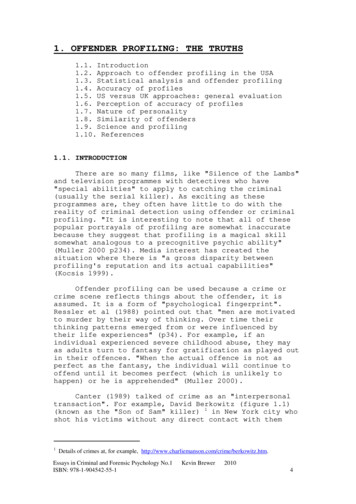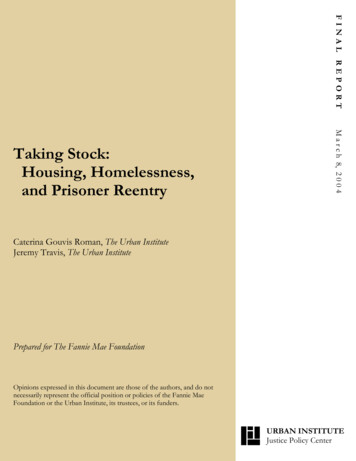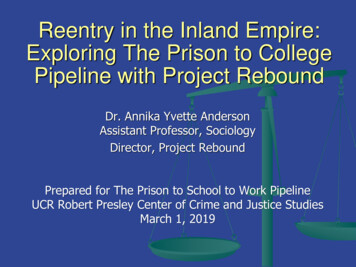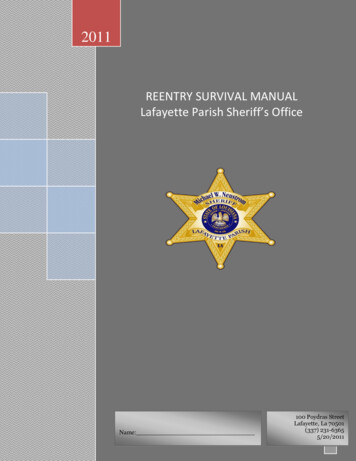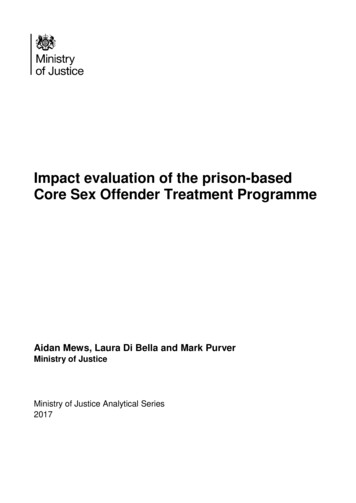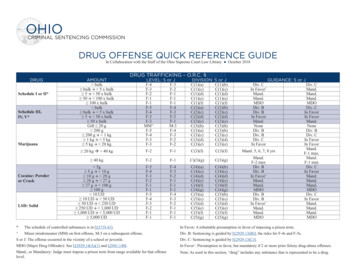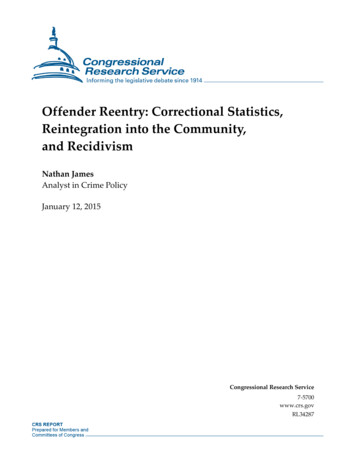
Transcription
Offender Reentry: Correctional Statistics,Reintegration into the Community,and RecidivismNathan JamesAnalyst in Crime PolicyJanuary 12, 2015Congressional Research Service7-5700www.crs.govRL34287
Offender Reentry: Correctional Statistics, Reintegration into the CommunitySummaryThe number of people incarcerated in the United States grew steadily for nearly 30 years. Thatnumber has been slowly decreasing since 2008, but as of 2012 there were still over 2 millionpeople incarcerated in prisons and jails across the country. The Bureau of Justice Statistics (BJS)reports that since 1990 an average of 590,400 inmates have been released annually from state andfederal prisons and almost 5 million ex-offenders are under some form of community-basedsupervision.Nearly all prisoners will return to their communities as some point. Offender reentry can includeall the activities and programming conducted to prepare prisoners to return safely to thecommunity and to live as law-abiding citizens. Some ex-offenders, however, eventually end upback in prison. The BJS’s most recent study on recidivism showed that within five years ofrelease nearly three-quarters of ex-offenders released in 2005 came back into contact with thecriminal justice system, and more than half returned to prison after either being convicted for anew crime or for violating the conditions of their release. Compared with the average American,ex-offenders are less educated, less likely to be gainfully employed, and more likely to have ahistory of mental illness or substance abuse—all of which have been shown to be risk factors forrecidivism.Three phases are associated with offender reentry programs: programs that take place duringincarceration, which aim to prepare offenders for their eventual release; programs that take placeduring offenders’ release period, which seek to connect ex-offenders with the various servicesthey may require; and long-term programs that take place as ex-offenders permanently reintegrateinto their communities, which attempt to provide offenders with support and supervision. There isa wide array of offender reentry program designs, and these programs can differ significantly inrange, scope, and methodology. Researchers in the offender reentry field have suggested that thebest programs begin during incarceration and extend throughout the release and reintegrationprocess. Despite the relative lack of highly rigorous research on the effectiveness of some reentryprograms, an emerging “what works” literature suggests that programs focusing on work trainingand placement, drug and mental health treatment, and housing assistance have proven to beeffective.The federal government’s involvement in offender reentry programs typically occurs throughgrant funding, which is available through a wide array of federal programs at the Departments ofJustice, Labor, Education, and Health and Human Services. However, only a handful of grantprograms in the federal government are designed explicitly for offender reentry purposes. TheDepartment of Justice has started an interagency Reentry Council to coordinate federal reentryefforts and advance effective reentry policies.The Second Chance Act (P.L. 110-199) was enacted on April 9, 2008. The act expanded theexisting offender reentry grant program at the Department of Justice and created a wide array oftargeted grant-funded pilot programs.Congressional Research Service
Offender Reentry: Correctional Statistics, Reintegration into the CommunityContentsBackground . 1Correctional System Statistics . 1Population in Correctional Facilities . 2Offenders Under Community Supervision . 3Probation . 4Parole. 4Recidivism . 5Bureau of Justice Statistics 2005 Recidivism Study . 6Limitations of Recidivism Statistics. 10Offender Reentry: A Brief Literature Review . 11Offender Reentry Defined . 12Program Effectiveness: The “What Works” Literature. 12Employment . 14Substance Abuse Treatment . 14Education. 14Mental Health . 15Housing . 15Limitations of the “What Works” Literature . 16Conclusions . 16Federal Offender Reentry Programs . 17Offender Reentry Programs at the Department of Justice (DOJ) . 17Offender Reentry Programs at Other Federal Agencies . 18The Department of Labor (DOL) . 19The Department of Education (DOE) . 19The Department of Housing and Urban Development (HUD) . 19The Department of Health and Human Services (HHS) . 20Coordination Between Federal Agencies . 20Conclusion . 21FiguresFigure 1. Number of Inmates Incarcerated in the United States, 2000-2013 . 3Figure 2. Number of Offenders Under Community Supervision, 2000-2013 . 5Figure 3. Proportion of Released Prisoners Arrested for the First Time at the End of theYear and Cumulative Percentage of Released Prisoners Rearrested . 7Figure 4. Proportion of Released Prisoners Rearrested, by Offense Type . 8Figure 5. Proportion of Released Prisoners Rearrested, by Criminal History . 9Figure 6. Measured Recidivism Based on Different Definitions of Recidivism . 10Congressional Research Service
Offender Reentry: Correctional Statistics, Reintegration into the CommunityTablesTable B-1. Authorized and Appropriated Funding for the DOJ Reentry Program, FY2001FY2008 . 32Table B-2. Authorized and Appropriated Funding for the Second Chance Act GrantPrograms Administered by the Department of Justice, FY2009-FY2015 . 32AppendixesAppendix A. Section-by-Section Summary of the Second Chance Act . 23Appendix B. Appropriations for DOJ Reentry Grant Programs . 32ContactsAuthor Contact Information. 33Congressional Research Service
Offender Reentry: Correctional Statistics, Reintegration into the CommunityBackgroundOver 95% of the prison population today will be released at some point in the future.1 Since 1990,an average of 590,400 inmates have been released annually from state and federal prisons.2 TheDepartment of Justice’s (DOJ’s) Bureau of Justice Statistics (BJS) has estimated that nearly threequarters of all released prisoners will be rearrested within five years of their release and about 6in 10 will be reconvicted.3 Many studies have indicated that reentry initiatives that combine worktraining and placement with counseling and housing assistance can reduce recidivism rates.4According to the BJS, the average per prisoner cost of incarceration in state prison in 2010 wasapproximately 28,000 per year.5 States collectively spent nearly 48.5 billion on theircorrectional systems in 2010, the most recent year for which data are available.6Offender reentry includes all the activities and programming conducted to prepare ex-convicts toreturn safely to the community and to live as law-abiding citizens. Reentry programs are typicallydivided into three phases: programs that prepare offenders to reenter society while they are inprison, programs that connect ex-offenders with services immediately after they are released fromprison, and programs that provide long-term support and supervision for ex-offenders as theysettle into communities permanently. Offender reentry programs vary widely in range, scope, andmethodology. The best-designed programs, according to the research in the field, are those thatspan all three phases.7Correctional System StatisticsTo understand the issue of offender reentry, one must first understand the ways in which exoffenders are released into the community. It is also worthwhile to analyze the population ofindividuals serving sentences in correctional facilities, because the number of offenders reentering the community is necessarily related to the number and type of offenders serving prisonsentences. This section analyzes national data on the nation’s correctional system.1U.S. Department of Justice, Office of Justice Programs, Bureau of Justice Statistics, “Reentry Trends in the UnitedStates,” http://www.bjs.gov/content/reentry/reentry.cfm; hereinafter “Reentry Trends.”2E. Ann Carson and Daniela Golinelli, Prisoners in 2012: Trends in Admissions and Releases 1991-2012, U.S.Department of Justice, Office of Justice Programs, Bureau of Justice Statistics, NCJ 243920, Washington, DC,December 2013, p. 3.3Matthew R. Durose, Alexia D. Cooper, and Howard N. Snyder, Recidivism of Prisoners Released in 30 States in2005: Patterns from 2005 to 2010, NCJ 244205, April 2014, p. 1.4Wilkinson, Reginald A., Director of the Ohio Department of Rehabilitation and Correction, “Offender Reentry: AStorm Overdue,” Paper Prepared for Third National Forum on Restorative Justice, March 2002, on file with the author.Hereinafter “A Storm Overdue.”5Tracey Kyckelhahn, State Corrections Expenditures, FY1982-2010, U.S. Department of Justice, Office of JusticePrograms, Bureau of Justice Statistics, NCJ239672, Washington, DC, December 2012, p. 4, Ibid., p. 11.7U.S. Department of Justice, Office of Justice Programs, “Learn About Reentry,” http://www.reentry.gov/learn.html.Congressional Research Service1
Offender Reentry: Correctional Statistics, Reintegration into the CommunityPopulation in Correctional FacilitiesThe correctional system includes two main forms of detention: jails and prisons. Jails, also knownas local lockups, are facilities generally used to temporarily detain individuals who have beenarrested or charged with a crime but not usually convicted.8 The jail population is thus extremelyfluid, with individuals usually staying for a matter of weeks, and includes individuals who maynever be convicted of a crime. Prisons, on the other hand, typically house individuals who havebeen convicted of a crime and sentenced to a term of one year or longer. For this reason, theprison population is less fluid than the jail population.The number of inmates incarcerated in correctional facilities steadily increased between 2000 and2008 when it reached its peak of nearly 2.4 million inmates. However, in recent years the numberof incarcerated individuals has declined. The number of inmates in prisons and local jailsdecreased by 15,400 (-0.7%) inmates in 2009; 21,900 (-1.0%) inmates in 2010; 30,400 (-1.3%)inmates in 2011; 11,300 (-0.5%) in 2012; and 9,000 (-0.4%) in 2013. The decrease in thecorrectional population in 2009 was the result of a declining jail population, but in 2010 and2011, there was a decrease in the number of inmates held in both jails and prisons. The overallcorrectional population decreased again in 2012, but this was the result of a decline in the numberof inmates held in prison; the number of inmates held in jails increased. While there was adecrease in the number of people incarcerated again in 2013, the number of people incarcerated inprisons actually increased between 2012 and 2013. The increase in the number of peopleincarcerated in prisons was offset by a decrease in the number of people incarcerated in jails.Figure 1 shows the number of inmates incarcerated in the United States from 2000 to 2013 (themost recent data available).8While this is generally the case, jails on occasion can also include individuals sentenced to prison terms lasting lessthan one year (misdemeanors) and convicted felons in jurisdictions where the prisons are overpopulated.Congressional Research Service2
Offender Reentry: Correctional Statistics, Reintegration into the CommunityFigure 1. Number of Inmates Incarcerated in the United States, 2000-2013Number of inmates in thousands3,000Number of inmates (in isonSource: The prison population counts were taken from U.S. Department of Justice, Office of Justice Programs,Bureau of Justice Statistics, Prisoners in 2011 and Prisoners in 2013. The jail population counts were taken fromU.S. Department of Justice, Office of Justice Programs, Bureau of Justice Statistics, Jail Inmates and Midyear2013—Statistical Tables.Given the fact that 95% of all inmates will eventually return to the community,9 the prisonpopulation has a direct impact on offender reentry. As the prison population grows, increasingnumbers of ex-offenders are released from correctional facilities. Most of these ex-offenders arerequired to undergo some form of community supervision as part of their release. The followingsection explores the mechanisms and statistics surrounding the release of prisoners into thecommunity.Offenders Under Community SupervisionEx-offenders can be released into the community through a variety of different mechanisms.Some offenders never serve prison sentences and instead serve their sentence on probation intheir communities under supervision. Others serve most of their sentences in correctionalfacilities but are then released on parole to finish their sentences in their communities under9Reentry Trends.Congressional Research Service3
Offender Reentry: Correctional Statistics, Reintegration into the Communitysupervision. Lastly, some offenders serve out their entire sentences in correctional facilities andare released unconditionally into the community.ProbationIndividuals who are found guilty of committing a crime that is deemed not serious enough forimprisonment can be sentenced to serve their sentences under community supervision(probation). Offenders on probation typically must adhere to certain conditions and check inregularly with their probation officers. Violation of these conditions or failure to appear beforetheir probation officers can lead to further criminal sanctions, including incarceration. In someinstances, offenders can be sentenced to a mixed term of prison and probation.ParoleIndividuals who have served most of their sentences in a correctional facility are sometimeseligible to complete their sentences in the community under conditional supervision. While somestates have a parole system in place, Congress abolished parole at the federal level effectiveNovember 1, 1987. However, there is a small percentage of federal offenders who were sentencedprior to November 1, 1987, who are still eligible for parole. The conditions associated with parolecan vary from case to case, but typically include drug testing and regular contact with a paroleofficer. Violations of these conditions can result in the parolee returning to prison to serve out theremaining portion of his or her sentence. There are two different kinds of parole: discretionaryand mandatory.Discretionary ParoleStates that use parole boards to determine whether a prisoner should be released into thecommunity have discretionary parole. Parole boards have the authority to conditionally release aprisoner into the community based on a statutory or an administrative determination that theprisoner is eligible.Mandatory ParoleStates that have statutory language determining when offenders should be released into thecommunity have mandatory parole. Jurisdictions that use determinate sentencing10 often includeprovisions specifying when inmates should be conditionally released from prison after serving aspecified portion of their original sentences.Figure 2 shows the number of offenders who were supervised in the community, either throughprobation or through parole, during the period from 2000 to 2013 (the most recent data available).The data show that the majority of offenders on community supervision are on probation (84%,on average, between 2000 and 2013). Also, trends in the number of people on communitysupervision mirror those of incarceration. The total number of people on community supervisionpeaked in 2007 (compared to the number of people incarcerated, which peaked in 2008) and it10A determinate sentence is a fixed sentence, while an indeterminate sentence is typically expressed as a range (i.e., 5to 10 years).Congressional Research Service4
Offender Reentry: Correctional Statistics, Reintegration into the Communityhas been declining since. The decline in the total number of people on community supervision haslargely been driven by a decline in the number of people on probation. The number of people onparole has actually increased since 2007, which might reflect the fact that a number of inmateswho were sentenced to terms of incarceration in the 1990s and early 2000s are now beingreleased on parole.Figure 2. Number of Offenders Under Community Supervision, 2000-2013Number of offenders in millionsNumber of people under community supervision (in 5200420032002200120000YearProbationParoleSource: The number of probationers and parolees were taken from U.S. Department of Justice, Office of JusticePrograms, Bureau of Justice Statistics, Probation and Parole in the United States, 2013.The relationship between the prison and parole populations is an important one for a number ofreasons. Offenders serving their sentences in prison have generally committed more seriouscrimes than offenders who serve their sentences in jail or on probation; as previously noted, theprison population typically includes individuals sentenced to more than a year of incarceration.Parolees, meanwhile, often return to the community after a prolonged period of incarceration andusually face a period of adjustment.RecidivismRecidivism is often defined as the rearrest, reconviction, or reincarceration of an ex-offenderwithin a given time frame. As a result of this broad definition of recidivism, most studies includetechnical violations of an offender’s parole or probation (such as failing a drug test or notCongressional Research Service5
Offender Reentry: Correctional Statistics, Reintegration into the Communityshowing up for a meeting, for example) within their general recidivism statistics. Rearreststatistics also include individuals who are found not guilty of the charges. For these reasons, somestudies have focused on reincarceration with a new prison sentence as a more accurate recidivismstatistic, arguing that technical violations are really an extension of an offender’s original prisonterm and not a newly committed crime. Essentially, there are two competing philosophies aboutwhat recidivism should mean.11 On the one hand are those who argue that any new contact withthe criminal justice system, no matter how minor, should be considered recidivism on the part ofan ex-offender. On the other hand are those who argue that recidivism should be more narrowlydefined as the commission of a new crime, resulting in a new sentence, by an ex-offender. Whatone includes in the definition of recidivism has a substantial impact on the rate of recidivismreported.Regardless of what definition is used, recidivism is a difficult subject to study. Trackingrecidivism involves following the cases of individuals for a number of years and relying on stateor national-level data sets that contain inherent inaccuracies. For example, if an offender isreleased in California but commits a new crime in Maine, the researchers must be able to matchthose two records together to make a definitive statement about recidivism. This match istypically done by consulting the FBI’s master database of convictions; however, as we will seelater, this database contains omissions that may affect the results of recidivism studies. A numberof studies have been conducted on this issue, and most states have calculated their own recidivismrates. However, for the sake of providing the most comprehensive overview of recidivism, thissection focuses on the most recently conducted national-level study.Bureau of Justice Statistics 2005 Recidivism StudyThe Bureau of Justice Statistics (BJS) study on the recidivism of a cohort of inmates released in1994 was, at the time, one of the most comprehensive national-level recidivism studies everconducted.12 The BJS recently published a new report that examined the recidivism rates for404,638 prisoners released in 30 states for five years after their release from prison in 2005.13 Theprisoners included in the study represent approximately three-quarters of the inmates released in2005. The 2005 BJS recidivism study used a larger sample and a longer follow-up period than the1994 study.14Data show that by the end of the five-year follow-up period, approximately three-quarters(76.6%) of prisoners released in 2005 were rearrested. Furthermore, the BJS found that mostreleased prisoners were rearrested within one year of being released. By the end of the first yearfollowing release, 43.4% of inmates were rearrested. The longer released prisoners went without11For an expanded discussion of the varying definitions of recidivism, refer to Allen Beck, Recidivism: A Fruit SaladConcept in the Criminal Justice World, Justice Concepts, available at e 1994 BJS study examined the rearrest, reconviction, and reincarceration of prisoners from 15 states three yearsafter their release in 1994. The study tracked 272,111 prisoners, or almost two-thirds of all the prisoners released fromstate prisons in 1994. Patrick A. Langan and David J. Levin, Recidivism of Prisoners Released in 1994, NCJ193427,June 2002.13Matthew R. Durose, Alexia D. Cooper, and Howard N. Snyder, Recidivism of Prisoners Released in 30 States in2005: Patterns from 2005 to 2010, NCJ 244205, April 2014.14The BJS cautions that because of factors like the different attributes of the prisoners included in the 1994 and 2005study, better data on inmates released in 2005 who died during the follow-up period, and improvements in thecompleteness of criminal history records, the results of the 2005 study are not directly comparable to the results of the1994 study. Ibid., pp. 2-5.Congressional Research Service6
Offender Reentry: Correctional Statistics, Reintegration into the Communitybeing rearrested, the less likely they were to be rearrested. As shown in Figure 3, compared to thearrest rate of 43.4% in the first year, 28.5% released prisoners who were not arrested in the firstyear were arrested for the first time in the second year after release. The proportion of releasedprisoners who were arrested for the first time over the course of the last three years of the followup period continued to decrease.Figure 3. Proportion of Released Prisoners Arrested for the First Time at the End ofthe Year and Cumulative Percentage of Released Prisoners Rearrested90%80%76.6%73.0%67.8%70%59.5%Percent %0%Year 1Year 2Year 3Year 4Year 5Year after releaseArrested for the first time during the yearCumulative percentage of prisoners arrestedSource: U.S. Department of Justice, Office of Justice Programs, Bureau of Justice Statistics, Recidivism of PrisonersReleased in 30 States in 2005: Patterns from 2005 to 2010.Notes: The denominators for the proportion of released prisoners arrested for the first time during the yearwere 404,638 for year one; 229,035 for year two; 163,679 for year three; 130,128 for year four; and 109,186 foryear five. The numerators include released prisoners who were arrested during the year who had not beenarrested since release.Data show that a greater proportion of released property offenders were rearrested than violent,drug, and public order offenders (see Figure 4). By the end of the five year follow-up period,82.1% of released property offenders were rearrested, compared to 76.9% of drug offenders,73.6% of public order offenders, and 71.3% of violent offenders. Data show that the generalpattern of recidivism shown in Figure 3 continued regardless of the offenses for which releasedprisoners were incarcerated. Most released offenders, regardless of their offense, were likely to berearrested within one year of being released and the increase in the proportion of rearrestedprisoners started to slow the longer prisoners had been out of prison.Congressional Research Service7
Offender Reentry: Correctional Statistics, Reintegration into the CommunityFigure 4. Proportion of Released Prisoners Rearrested, by Offense Type90%80%70%Percent arrested60%50%40%30%20%10%0%61224364860Time after release (in months)PropertyDrugPublic OrderViolentSource: U.S. Department of Justice, Office of Justice Programs, Bureau of Justice Statistics, Recidivism of PrisonersReleased in 30 States in 2005: Patterns from 2005 to 2010.The BJS also found that prisoners with longer criminal histories were more likely to be rearrestedwithin five years of being released. Data show that 86.5% of released prisoners with 10 or moreprior arrests were rearrested within five years (see Figure 5). In comparison, 60.8% of releasedprisoners with four or fewer prior arrests and 75.9% of released prisoners with five to nine priorarrests were rearrested within five years.Congressional Research Service8
Offender Reentry: Correctional Statistics, Reintegration into the CommunityFigure 5. Proportion of Released Prisoners Rearrested, by Criminal History100%90%80%Percent arrested70%60%50%40%30%20%10%0%61224364860Time after release (in months)10 or more prior arrests5-9 prior arrests4 or fewer prior arrestsSource: U.S. Department of Justice, Office of Justice Programs, Bureau of Justice Statistics, Recidivism of PrisonersReleased in 30 States in 2005: Patterns from 2005 to 2010.As previously discussed, the definition of “recidivism” can affect measured recidivism. The datafrom the BJS study bear this out. Arrest is the broadest definition of recidivism, and when thisdefinition is used it produces the highest measured recidivism (see Figure 6). More restrictivedefinitions of recidivism result in lower measured recidivism. For example, 76.6% of prisonersreleased in 2005 were rearrested within five years, but 60.0% were adjudicated,15 55.4% wereconvicted for a new crime, 55.1% were returned to prison,16 44.9% were incarcerated,17 and28.2% were imprisoned.1815“Adjudicated” refers to arrests that resulted in a subsequent court adjudication or disposition (e.g., convictions,dismissals, acquittals, or deferred adjudications).16“Returned to prison” refers to arrests that resulted in a conviction with a disposition of a prison sentence or whenprisoners were returned to prison without a new conviction due to technical violations of the terms of their release (e.g.,failing a drug test or missing an appointment with a parole officer).17“Incarcerated” refers to arrests that resulted in a prison or jail sentence.18“Imprisoned” refers to arrests that resulted in a prison sentence.Congressional Research Service9
Offender Reentry: Correctional Statistics, Reintegration into the CommunityFigure 6. Measured Recidivism Based on Different Definitions of Recidivism90%80%Precent recidivated70%60%50%40%30%20%10%0%61224364860Time after release (in months)ArrestedReturn to entSource: U.S. Department of Justice, Office of Justice Programs, Bureau of Justice Statistics, Recidivism of PrisonersReleased in 30 States i
The Second Chance Act (P.L. 110-199) was enacted on April 9, 2008. The act expanded the existing offender reentry grant program at the Department of Justice and created a wide array of targeted grant-funded pilot programs. Offender Reentry: Correctio
